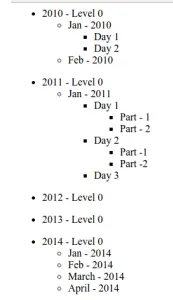我有一个新的想法,我认为它会很好。
这个想法是:
在 category_parent 列中,我们将插入对此节点所有父级的引用。
+----+----------------------+-----------------+
| id | category_name | hierarchy |
+----+----------------------+-----------------+
| 1 | cat1 | 1 |
+----+----------------------+-----------------+
| 2 | cat2 | 2 |
+----+----------------------+-----------------+
| 3 | cat3 | 3 |
+----+----------------------+-----------------+
| 4 | subcat1_1 | 1-4 |
+----+----------------------+-----------------+
| 5 | subcat1_2 | 1-5 |
+----+----------------------+-----------------+
| 6 | subsubcat1_1 | 1-4-6 |
+----+----------------------+-----------------+
| 7 | subsubcat1_2 | 1-4-7 |
+----+----------------------+-----------------+
| 8 | subsubcat1_3 | 1-4-8 |
+----+----------------------+-----------------+
| 9 | subsubcat1_3_1 | 1-4-8-9 |
+----+----------------------+-----------------+
| 10 | subsubcat1_3_2 | 1-4-8-10 |
+----+----------------------+-----------------+
| 11 | subsubcat1_3_1_1 | 1-4-8-9-11 |
+----+----------------------+-----------------+
| 12 | subsubsubcat1_3_1_1 | 1-4-8-9-12 |
+----+----------------------+-----------------+
| 13 | subsubsubcat1_3_1_2 | 1-4-8-9-11-13 |
+----+----------------------+-----------------+
| 14 | subsubsubcat1_2_1_3 | 1-4-8-9-11-14 |
+----+----------------------+-----------------+
如果您查看我的更新表,您会注意到每条记录都有其父级的链接,不仅是直接的父级,还包括所有父级。
为此,我对插入进行了一些修改:
Insert into table_name (category_name, hierarchy) values ('new_name', (concat(parent_hierarch, '-', (SELECT Auto_increment FROM information_schema.tables WHERE table_name='table_name'))))
现在让我们制作您想要的查询:
1- 所有汽车的子类别:
select * from table_name where hierarchy like '1-%'
2- 如果你需要获取BLACK的所有父级元素,只需输入:
select * from table_name where hierarchy = '1-4-8-9' or hierarchy = '1-4-8' or hierarchy = '1-4' or hierarchy = '1'
(您可以通过PHP构建该查询,将层次结构字段在“-”字符处拆分)
3- 查看所有类别,包括级别和直接父级:
select *, SUBSTR(hierarchy, 1, (LENGTH(hierarchy) - LENGTH(id) - 1)) as parent, LENGTH(hierarchy) - LENGTH(REPLACE(hierarchy, '-', '')) as level From table_name
+----+----------------------+-----------------+-----------+--------+
| id | 分类名称 | 层级 | 父级 | 等级 |
+----+----------------------+-----------------+-----------+--------+
| 1 | cat1 | 1 | | 0 |
+----+----------------------+-----------------+-----------+--------+
| 2 | cat2 | 2 | | 0 |
+----+----------------------+-----------------+-----------+--------+
| 3 | cat3 | 3 | | 0 |
+----+----------------------+-----------------+-----------+--------+
| 4 | subcat1_1 | 1-4 | 1 | 1 |
+----+----------------------+-----------------+-----------+--------+
| 5 | subcat1_2 | 1-5 | 1 | 1 |
+----+----------------------+-----------------+-----------+--------+
| 6 | subsubcat1_1 | 1-4-6 | 1-4 | 2 |
+----+----------------------+-----------------+-----------+--------+
| 7 | subsubcat1_2 | 1-4-7 | 1-4 | 2 |
+----+----------------------+-----------------+-----------+--------+
| 8 | subsubcat1_3 | 1-4-8 | 1-4 | 2 |
+----+----------------------+-----------------+-----------+--------+
| 9 | subsubcat1_3_1 | 1-4-8-9 | 1-4-8 | 3 |
+----+----------------------+-----------------+-----------+--------+
| 10 | subsubcat1_3_2 | 1-4-8-10 | 1-4-8 | 3 |
+----+----------------------+-----------------+-----------+--------+
| 11 | subsubcat1_3_1_1 | 1-4-8-9-11 | 1-4-8-9 | 4 |
+----+----------------------+-----------------+-----------+--------+
| 12 | subsubsubcat1_3_1_1 | 1-4-8-9-12 | 1-4-8-9 | 4 |
+----+----------------------+-----------------+-----------+--------+
| 13 | subsubsubcat1_3_1_2 | 1-4-8-9-11-13 |1-4-8-9-11 | 5 |
+----+----------------------+-----------------+-----------+--------+
| 14 | subsubsubcat1_2_1_3 | 1-4-8-9-11-14 |1-4-8-9-11 | 5 |
+----+----------------------+-----------------+-----------+--------+
这是一个新思路,需要一些改进。

$list。 - Rob Schmuecker